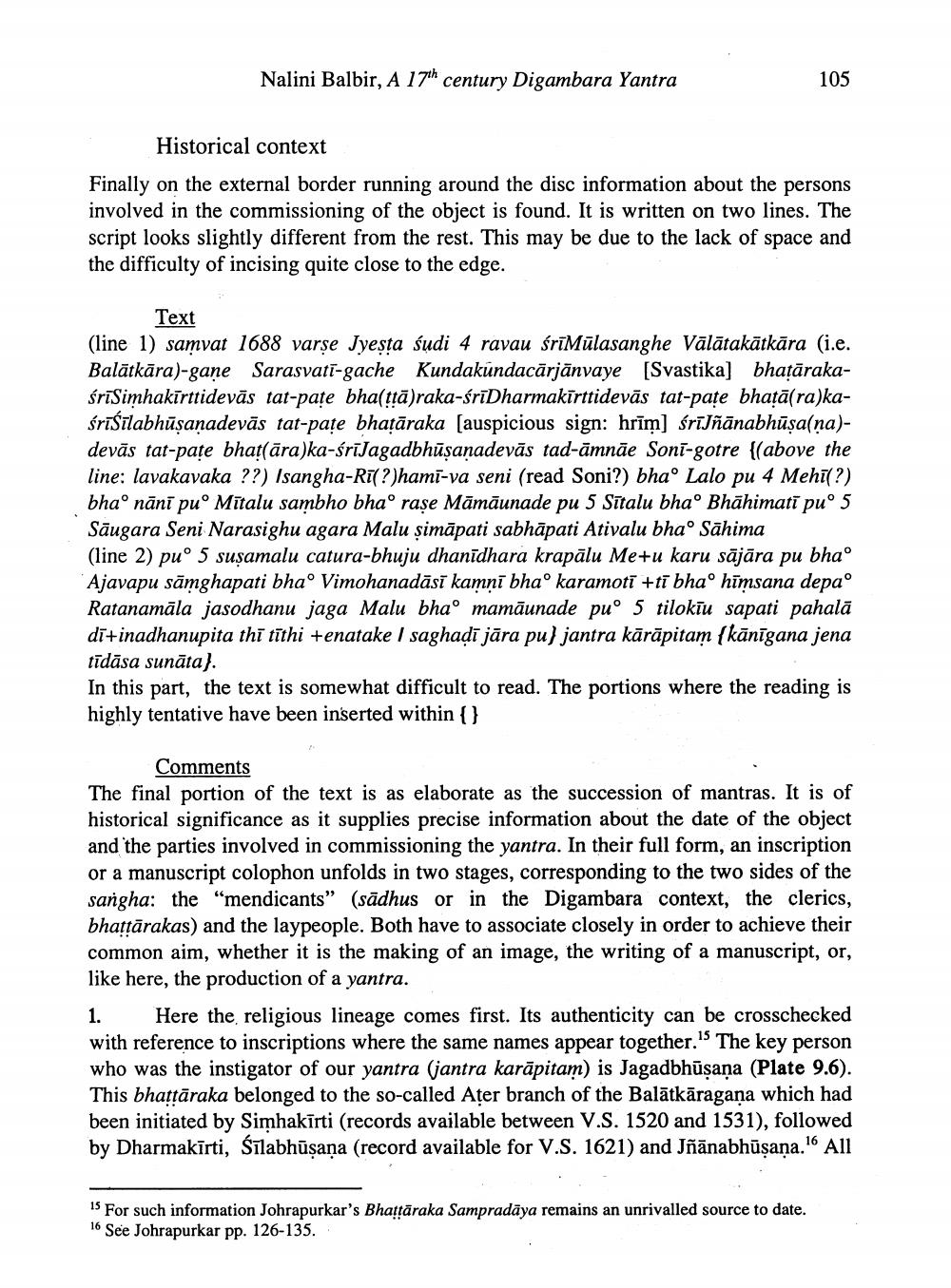________________
Nalini Balbir, A 17th century Digambara Yantra
105
Historical context
Finally on the external border running around the disc information about the persons involved in the commissioning of the object is found. It is written on two lines. The script looks slightly different from the rest. This may be due to the lack of space and the difficulty of incising quite close to the edge.
Text
(line 1) samvat 1688 varse Jyesta śudi 4 ravau śrīMūlasanghe Vālātakātkāra (i.e. Balätkära)-gane Sarasvati-gache Kundakundacärjänvaye [Svastika] bhaṭārakaśriSimhakirttidevās tat-pate bha(ṭṭā)raka-śrīDharmakīrttidevās tat-pate bhaṭā(ra)kaśriŠilabhūṣaṇadevās tat-pate bhaṭāraka [auspicious sign: hrim] śrīJñānabhūṣa(na)devās tat-pate bhaṭ(āra)ka-śrīJagadbhūṣaṇadevās tad-āmnãe Soni-gotre {(above the line: lavakavaka ??) Isangha-Ri(?)hami-va seni (read Soni?) bha' Lalo pu 4 Mehi(?) bha nānī pu° Mitalu sambho bha° raṣe Māmāunade pu 5 Sitalu bha Bhāhimati pu° 5 Săugara Seni Narasighu agara Malu şimāpati sabhāpati Ativalu bha Sahima
(line 2) pu° 5 sușamalu catura-bhuju dhanidhara krapālu Me+u karu sājāra pu bha Ajavapu sämghapati bha° Vimohanadāsī kamni bhao karamoti +ti bha° himsana depa° Ratanamäla jasodhanu jaga Malu bha mamãunade pu° 5 tilokiu sapati pahalā di+inadhanupita thi tithi +enatake I saghaḍī jāra pu) jantra käräpitam (kānīgana jena tīdāsa sunāta).
In this part, the text is somewhat difficult to read. The portions where the reading is highly tentative have been inserted within {}
Comments
The final portion of the text is as elaborate as the succession of mantras. It is of historical significance as it supplies precise information about the date of the object and the parties involved in commissioning the yantra. In their full form, an inscription or a manuscript colophon unfolds in two stages, corresponding to the two sides of the sangha: the "mendicants" (sādhus or in the Digambara context, the clerics, bhaṇṭārakas) and the laypeople. Both have to associate closely in order to achieve their common aim, whether it is the making of an image, the writing of a manuscript, or, like here, the production of a yantra.
1.
Here the religious lineage comes first. Its authenticity can be crosschecked with reference to inscriptions where the same names appear together.15 The key person who was the instigator of our yantra (jantra karäpitam) is Jagadbhūṣaṇa (Plate 9.6). This bhaṇṭāraka belonged to the so-called Ater branch of the Balatkaragana which had been initiated by Simhakirti (records available between V.S. 1520 and 1531), followed by Dharmakirti, Śīlabhūṣaṇa (record available for V.S. 1621) and Jñänabhüṣaṇa. All
15 For such information Johrapurkar's Bhaṭṭāraka Sampradaya remains an unrivalled source to date. See Johrapurkar pp. 126-135.
16




